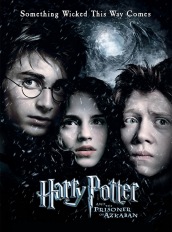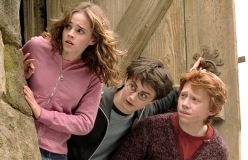| Harry Potter and the Prisoner of Azkaban |
| |
 |
USA, 2004. Rated PG. 142 minutes.
Cast:
Daniel Radcliffe, Emma Watson, Rupert Grint, Gary Oldman, David Thewlis, Alan Rickman, Emma Thompson, Michael Gambon, Robbie Coltrane, Richard Griffiths, Fiona Shaw, Pam Ferris, Maggie Smith, Julie Christie, Timothy Spall
Writer: Steve Kloves, based on the novel by JK Rowling
Original Music: John Williams
Cinematography: Michael Seresin
Producers: Chris Columbus, David Heyman, Mark Radcliffe
Director: Alfonso Caurón
LINKS
|
 magination is the bane of book adaptations. We each have our own vision of a book's contents floating around in our heads, and seeing another man's differing vision of the book can be difficult, even irritating. This isn't the crux of the argument against film adaptations of books, but it's one of the biggest complaints, big enough to pose a reasonable problem for J.K. Rowling's “Harry Potter” series. Except for the absence of robes, though, everything about Chris Columbus' Hogwarts was about as canon (or close to the text) as you could get.
magination is the bane of book adaptations. We each have our own vision of a book's contents floating around in our heads, and seeing another man's differing vision of the book can be difficult, even irritating. This isn't the crux of the argument against film adaptations of books, but it's one of the biggest complaints, big enough to pose a reasonable problem for J.K. Rowling's “Harry Potter” series. Except for the absence of robes, though, everything about Chris Columbus' Hogwarts was about as canon (or close to the text) as you could get.
The first two “Harry Potter” pictures featured a wide and golden Hogwarts lit by candles and fueled by invisible enchantments, with cozy Common Rooms and stylish uniforms for its students. Now all that has been crumpled into a ball, dropped, and kicked into a fireplace by Alfonso Caurón (A Little Princess, Y Tu Mama Tambien), Columbus' successor for Harry Potter and the Prisoner of Azkaban. Cauròn's Hogwarts is darker, more mechanical, and more complex. The Great Hall, instead of being a place of perpetual gawking, is just one big school cafeteria with the sky as a roof. Classrooms, instead of being showcases for brilliant and seasoned British actors, are places where students vent their frustrations against each other in secret when the teacher's not looking. The Common Rooms, instead of being place s where young actors sit around and look at the fireplace, are places where students bond. In short, Cauròn's Hogwarts is nothing short of your average school. Except, of course, that it's completely magic.
Harry Potter and the Prisoner of Azkaban is, without doubt, the best Harry Potter movie thus far simply because it's about humans, and not witches and wizards solving mysterious mysteries. There is a “mystery” at hand in Prisoner of Azkaban—the escape of wizard convict, Sirius Black (Gary Oldman), and his connection with Harry Potter (Daniel Radcliffe)—but the story is all about Harry's growing up. That's closer to canon than Columbus' Sorcerer's Stone and Chamber of Secrets ever got to. Underneath the magic, that's what the books are really about.

Emma Watson, Daniel Radcliffe, and Rupert Grint in Harry Potter and the Prisoner of Azkaban. |
Harry Potter's year begins with a frustrating visit from his Aunt Marge (Pam Ferris), who doesn't hesitate to insult Harry and his family at the slightest opportunity. Once she goes too far, comparing Harry and his mother to a female dog and her pup, and winds up pushing the wrong button on Harry's hormone machine. Infuriated, Harry somehow inflates her like a balloon and promptly takes the time to bolt while his live-in relatives, the Dursleys, are still in shock.
Out in the great suburban beyond, Harry takes a trip on a fast purple triple-decker called the Knight Bus, where he first learns of Sirius Black. Later he discovers that Black may have escaped the wizard prison Azkaban on a mission to kill Harry, as revenge against Potter's defeat of Voldemort, the dark wizard Black allegedly followed. Harry is told to be extra cautious at school, where he must face more woe in the forms of Dementors, dark creatures that feed off happy thoughts and leave humans empty. Thankfully new Defense Against the Dark Arts professor Remus J. Lupin (David Thewlis) takes Harry under his wings, teaching him ways to defend himself against the Dementors as well as sharing memories of old classmates James and Lily—Harry's parents.
Kloves' screenwriting has improved much from the first two films. He has taken some artistic liberties (at last!), and stopped making the stories into Hardy Boys-esque mystery capers. Yet he's still not good enough. His script, while rife with great dialogue, does not hold the intrigue, mystery, and depth of the books, nor does he even bother to maintain Rowling's intricate plotting, opting instead to bring to screen only those scenes that are most exciting, rather most relevant to the plot. Plus he has an odd fixation with Hermione (Emma Watson) that results in the equivalent of a “Mary Sue” in fan fiction—a beautiful, exceptionally talented and flawless female character whom nobody but the Supremely Evil hates. In a movie where Harry's flaws are hung out to dry, writing a perfect, flawless character is inexcusable.
Cauròn, on the other hand, needs to come back for Harry Potter and the Order of the Phoenix, book five of the Harry Potter series. The Order of the Phoenix brings to a climax all the issues Harry deals with in The Prisoner of Azkaban—anger, depression, and loneliness. It is one of the key points in Harry's growth, one that Cauròn could turn into a coming-of-age masterpiece (with the right screenwriter, of course). Already in Prisoner of Azkaban he has tapped into a side of Harry that's only been seen thus far in the books—the angry orphan seeking revenge for his parents' murders, trying to comprehend human cruelty while failing to see the same cruelty in himself. While Kloves may be credited for giving Harry lines to express his sorrow, it's the magic Cauròn works through Radcliffe that brings this Harry to life. Radcliffe has transformed into an actor who can hold is own against veterans like Gary Oldman. That's a huge step up from Christian Coulson, who played the manipulative Tom Riddle in The Chamber of Secrets.
One scene that sticks out as proof that Cauròn is the better director is a scene where Harry and his classmates Ron (Rupert Grint), Neville (Matthew Lewis), Seamus (Devon Murray), and Dean (Alfred Enoch) eat candy in their dorm room. The focal point is the boys simply having fun and bonding—something that we also haven't seen in Columbus' world. Cauròn then cuts to an exterior shot of Hogwarts, where the Dementors guard the school with their menacing presence. Cauròn often resorts to shots of them floating about the castle, freezing anything that gets in their way, as a means to symbolize the dangers awaiting our adolescent heroes outside their gilded home. Since the Dementors are Rowling's representation of depression, those “dangers” aren't shallow. That's the kind of depth and artistry that's been missing from this series, but though Cauròn ought to be commended for his Promethean daring, he is a little too artsy for his own good. Making the drastic changes he did to the look of the film is almost suicidal, if not highly confusing.
However, if the producers allowed Cauròn to make as many changes as he did, they ought to have allowed him to change everything to suit his vision. As it is, there are certain elements of Prisoner of Azkaban that stick out like a sore thumb, most noticeably John Williams' score. Year after year Williams has written brilliant themes for the Harry Potter franchise. This year he's managed to combine a frantic jazz piece, a waltz, and touches of A.I. Artificial Intelligence and Minority Report into one comprehensive score. But Prisoner of Azkaban needed Danny Elfman, not John Williams. If Warner Brothers insists on keeping Williams, they must try hard to get a director Williams is comfortable working with (Spielberg, perhaps?). Otherwise it's time to let another composer take a shot at Potter.
Besides the change in director, the several additions to the cast are just as refreshing as Cauròn. No disrespect to the late Richard Harris, but Michael Gambon, Harris 's replacement as Dumbledore in Prisoner of Azkaban , plays Dumbledore like he's supposed to be played (a tad bit off his rocker, but gentle and kind). Oldman fits the role of Sirius Black to a T. He's insane with a glint that harkens back to his days as a mischievous teenager and a look that remains aristocratic under years of neglect at Azkaban. Thewlis, on the other hand, may not be what people had in mind when they read about Remus Lupin, but his warm and weary portrayal of Lupin does the poor soul more than enough justice on screen. It's a pity we won't see Thewlis at it again until film five. Emma Thompson rounds up the newcomers as Sybil Treenlawny, professor of Divination, 99 percent hack and 1 percent genuine. That's not a comment on Thompson's comical performance, which, like those of Thewlis and Oldman, leaves the audience waiting for more.
Cauròn's direction also does the returning cast members a favor—their performances are a great deal better than in Chamber of Secrets. Tom Felton in particular has transformed into the cowardly bully that is Draco Malfoy. His character might be one we love to hate, but Felton is no less entrancing when he's strutting (or whimpering) on screen. Grint has landed himself squarely in the love-him-or-hate-him camp. Personally, I love him and his priceless comic timing. Watson, meanwhile, plays Hermione with much charisma and spark that also suggests the rebellious streak in the otherwise straitlaced Hermione. In the few minutes she has Maggie Smith still manages to wow by playing an informal side of McGonagall during one short scene. Alan Rickman, though, may need to wait until The Goblet of Fire until he can gain back the allure he had in Sorcerer's Stone.
Undoubtedly Cauròn has raised the bar high for the “Harry Potter” franchise. He has successfully brought a level of artistry to what could have been an unimaginative studio product. Yet someone could still do it better than Cauròn. Had the director a full comprehension of the series, and not a once-sided focus like Cauròn on Harry's anger, and the full confidence of the studio to make as many wise changes as he would like, and of course the talent and the luck to back up such changes, then it's quite possible that at least one Harry Potter movie could contend with The Lord of the Rings. Until then Cauròn's fanciful world is more than sufficient enough.
Here's well-wishes to Mike Newell (Four Weddings and a Funeral), director of the next picture, Harry Potter and the Goblet of Fire.
Review © June 2004 by AboutFilm.Com and the author.
Images © 2004 Warner Bros. All Rights Reserved.


